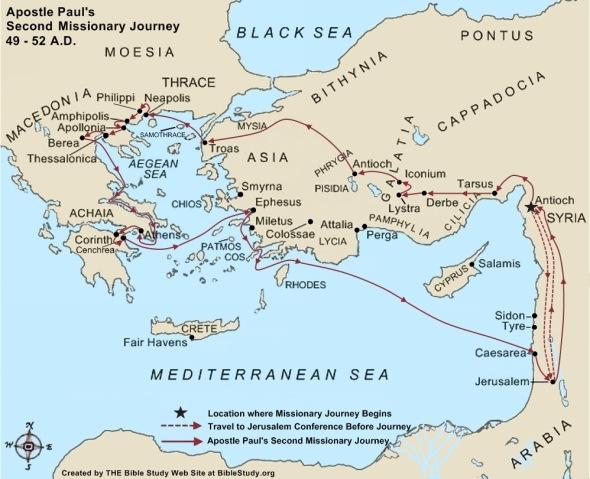Paul’s Second Missionary Journey
15:36 to 18:22
49-52 AD
The edict of Claudius expelling Jews from Rome
Paul wrote First and Second Thessalonians (about the end times) in 50 AD from Corinth
(to see link click Cc – Many Respond to the Good News in Corinth: the blessing of converts).
Paul saw himself above all as Messiah’s apostle to the Gentiles (Romans 1:5, 15:18; Galatians 2:8). This calling is very much confirmed by the account of his missionary activity in Acts. His witness to the Gentiles was first revealed at his conversion (9:15), and was exemplified by his joining Barnabas in evangelizing the Gentiles from Antioch (to see link click Bn – Barnabas and Sha’ul Sent Out from Syrian Antioch). On his First Missionary Journey this special calling was confirmed for him in the conversion of the Roman proconsul, Sergius Paulus, on Cyprus (13:12), in the mass response of the Gentiles in Pisidian Antioch (13:48), and in the formation of a group of disciples at Lystra (14:20). At Jerusalem, Paul’s witness to the Gentiles was confirmed by the apostles and elders of the mother church, and the way was cleared for his further ministry. Paul was then ready for a major outreach to the Gentiles.349
The most notable feature of Paul’s Second Missionary Journey is that the good seed of the gospel was, for the first time, planted in European soil. Of course, there was in those days no line of demarcation between “Asia” and “Europe,” and the missionaries sailed across the northern part of the Aegean Sea were conscious of traveling only from one province to another, not from one continent to another, since both shores of the Aegean belonged to the Roman Empire. In spite of that, the invasion of Europe was not in the mind of Paul, but it was evidently in the mind of the Spirit of God.350 With the benefit of hindsight, knowing that Europe became the first Christian continent and was, until a century ago, the main base for missionary outreach to the rest of the world, we can see what an epoch-making development this was. It was from Europe that, in due time, the gospel fanned out to the great continent of Africa, Asia, North America, Latin America, and therefore reached the ends of the earth.
What Paul and his companions were conscious of doing was to establish new churches in the three Roman provinces during the Second Missionary Journey, which they had not penetrated during the First Missionary Journey. In the First they had concentrated exclusively on Cyprus and Galatia. But in the Second they reached Macedonia and Achaia, establishing churches at Thessalonica the capital of Macedonia, and at Corinth the capital of Achaia. Not only that, they just touched the province of Asia by visiting Ephesus, promising to return during their next journey.351
Taking the gospel to the end of the earth (1:8) is particularly applicable for the first part of their mission, where Paul was extensively involved in travel from Sryian Antioch to Troas (see Bx – Paul’s Vision of the Man of Macedonia). The pace slowed down thereafter with more extensive stays and establishment of churches in Philippi (see By – Lydia’s Conversion in Philippi), Thessalonica and Berea (see Ca – Synagogue Responses Vary to Paul’s Visit). After a seemingly brief visit to Athens with his notable address from the Areopagus (Cb – An Unknown God in Athens), Paul concluded this period of ministry in Corinth, staying there at least eighteen months (see Cc – Many Respond to the Good News in Corinth) before returning to Syrian Antioch.352 Here, once again, we see a mix of successes and opposition.




Leave A Comment